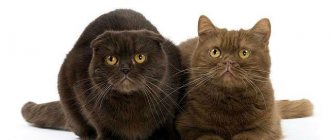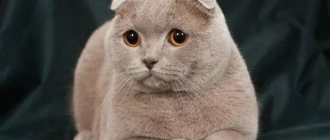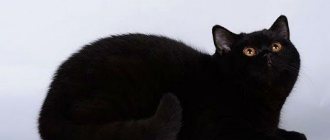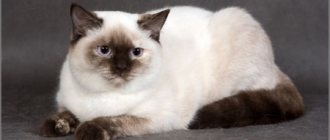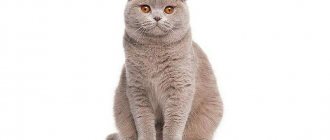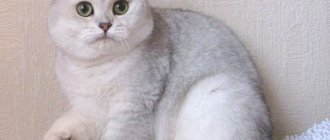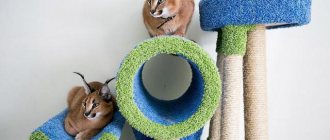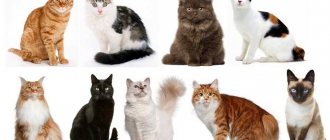Many people love cats. Many people also like ginger cats. You shouldn’t be surprised by this - this color of cat fur is pleasing to the eye and can even contribute to the owner’s good mood. Such animals can often be found just on the street, and the most beautiful ones are shown at exhibitions. Red, or rather “red” color is characteristic of many cat breeds, which will be discussed below.
Characteristic features of the “red” color
Pedigree red cats have a special beauty. Not many people know the fact that there are much fewer red cats than male cats. True, this can only be said about pure red animals. Much more often they are striped or with spots of other colors. Often the red stripes alternate with white or black. You can see this in the photo below.
Males, as a rule, have a pure red color, and these are mainly purebred animals. This phenomenon can be explained by the genetic characteristics of the cat family. At the same time, the red color is characterized by the following specific feature: it is a marbled shade and stripes. There are also breeds of red cats with a coat color that is called “coffee au lait.”
If a kitten that was recently born has red genes and so-called diluent genes from its parents, then the baby’s fur may not be brightly fiery, but acquire a pleasant creamy tint.
But be that as it may, the “red” color is considered special, since in most cases the colors of a cat’s fur come from genes with black pigment. The gene for red color can be called “individual”, possessing specific qualities.
Among the main features of cats with a red color, the following should be highlighted:
- First of all, it is worth understanding that most ginger cats are males. This is explained by the fact that pigment genes are concentrated on the sex X chromosome. And cats have only one such chromosome, which they receive from their mother. For this reason, males have a greater chance of being born with a red color. Cats have two such chromosomes. Therefore, a cat can be born red if it receives the genes for the “red” pigment from both mom and dad;
- secondly, you should know that there are practically no ginger cats that have no pattern on their fur. This can be explained by the fact that many animals have a gene called “non-agouti”. It does not allow the designs to appear in the offspring. But since red felines have the gene for their native color, the effect of “non-agouti” is neutralized in them, which leads to the appearance of patterns on the fur of kittens.
As a result, if you see a ginger cat without visible patterns on the fur in the form of stripes, spots or stains, then this is the so-called cinnamon color, which was obtained due to the influence of the black pigment gene.
The power to heal
According to legend, if a ginger cat is next to a sick person, even after surgery, that person will recover sooner. Even today, many owners of such animals can tell about the healing abilities of animals.
It is a generally accepted fact that a cat with a fiery coat color is a real charge of positivity and optimism. By creating an appropriate life-affirming mood, it literally works wonders, truly becoming an excellent medicine. It won’t be difficult for her to relieve her owner’s stress. And for those who suffer from migraine attacks and pressure changes, the benefits that fire cats can bring are priceless.
What eye color can ginger cats have?
By nature, all cats initially had green eyes. A little later, thanks to the efforts of specialist breeders, cats with blue, yellow and orange eyes were bred. In purebred animals, copper-colored eyes are much more common, although ordinary kittens also have yellow or blue eyes.
A certain eye color in small kittens can only be seen a few weeks after birth. For this reason, it is not possible to know in advance what the eyes of babies will be like. If a newborn's eyes appear brown at first, it is likely that they may later turn orange. The same applies to the initially yellow color scheme. Grayish can very possibly turn into blue.
Smoky (smoky, tuxedo)
The color of Scottish Fold cats can be smoky. On top the coat is one color, for example black. And at the base, each hair is silvery-white. This coloring is characteristic of cats with a dominant silver gene, which creates unusual combinations of light and dark shades.
Smoky color is easy to confuse with solid color. To avoid mistakes, you just need to look at the undercoat. With a smoky color, the undercoat of a different shade is clearly visible, and with a solid color, the color of the roots does not differ from the tips.
The eyes of smoke cats are usually yellow-gold in color. Based on the shades of smoke on the fur, several subspecies of this color of animal are distinguished.
Blue smoke
Smoky blue Scottish Straights and Scottish Folds are distinguished by the color of their fur coat with a gray cold coating. But underneath the fur is white and silvery. The paw pads and nose of these pets are gray-blue.
Black smoke
This color in Scottish cats is characterized by a black edge, but the hair at the roots is white. The nose mirror and pads do not differ from the main background.
Chocolate smoke
The snow-white undercoat is combined with a brown-chocolate topcoat. The nose button and paw pads of these animals are brown in color.
Smoky Scottish Straights and Scottish Folds, despite their unique color, cannot participate in exhibitions. Such cats are not recognized by the breed standard.
Personality of cats with red coat color
It is impossible to describe the future character of red cats and cats in a few phrases. Some breeds behave very calmly, others can be unapproachable, and still others can even become “fighters.” The behavior of pets with a red color is completely unpredictable, and over time the character of the animal can change. As children, they are playful, like all little kittens. They cannot sit still, constantly looking for entertainment and “toys.” But with age, they can turn into an affectionate pet or a “defender of the territory”, not allowing “strangers” into the house. They can hiss at strangers and even lunge at them with their claws.
Please note that ginger cats quite often get along peacefully with other pets living in a house or apartment.
Next, let's look at the cat breeds in which red color is most common.
Color point or acromelanism
The English phrase color point is translated as “color spot”. With this color, kittens are born blue-eyed and almost snow-white. With age, most of their body remains either white or changes to cream, and its extremities (muzzle, tail, ears, paws) darken and acquire more saturated colors:
- tortoiseshells;
- solids;
- tabby
Color point is a form of albinism. It is part of the group of acromelanistic colors that depend on body temperature. So-called points, or dark spots, appear where it is colder. The snow-white appearance of kittens is the result of their high temperature, which is 38.5-39.5°C. In adults, this figure is much lower – 37.5-38.9°C.
Varieties by shade
Depending on the main color of the cat and its point, several subspecies are distinguished in this group. These include:
- blue point - blue;
- chocolate point – brown;
- tortoiseshell (tri-color);
- lilac point – gray-pink;
- seal point – dark brown-gray, close to black;
- red point – red (red);
- cream point – cream (beige);
- tabby point - spotted or striped.
The acromelanism gene can also produce full albinos. Such cats not only have little, but basically no melanin. Because of this, not only their fur coat loses color, but also the iris. Albino cats have either pinkish-red or blue eyes. In the first case, the color comes from blood vessels, and in the second, from reflected rays of light.
Examples of breeds
An alternative name for color point is Siamese. It’s easy to guess that its main owners are the graceful and big-eared Siamese. Acromelanism also appears in their close relatives – Thai and Himalayan cats.
American shorthair cat
Animals of this breed often have strong bones and a muscular, large figure. They have a beautiful head with a neat, regular shape. As a rule, such pets are very friendly, have excellent health and have all the habits of ordinary cats, because the ancestors of the American Shorthair are ordinary street cats that lived in the United States of America for more than several hundred years. Nowadays, many Americans...
Norwegian redheads
These cats are characteristically distinguished from other similar breeds by the presence of peculiar tassels on the tips of their ears. In this way they are somewhat reminiscent of small lynxes. Such animals can have different fur colors, but if you find a Norwegian red pet, then you are in luck. You can breed them and make good money from it.
As for the nature of such animals, they are quite affectionate, gentle, and sometimes very playful. Pets are very attached to their owners, love small children and do not show any aggression towards them, even if children pull their tail or ears. These are true friends of a person who will never change their home.
How to care?
Caring for cats of different breeds is almost the same. Everyone needs to be given not only love and affection, but also proper food and hygiene procedures.
First of all, the cat must be toilet trained from the first days. In addition, the filler in it should be changed as often as possible so that the unpleasant odor does not spread throughout the apartment. It is also recommended to trim your pet's claws once a month. This must be done very carefully so as not to damage the vessels. If you have a scratching post, it is not necessary to trim your nails.
It is very important to take care of your pets' fur - it must be combed regularly. For short-haired cat breeds, it is enough to do this once a week, but those with long hair will have to be accustomed to daily grooming. Brush with a blunt-toothed brush to avoid causing irritation to the skin.
Many pets will need to be bathed. The number of such procedures depends on the breed of cat. Most often they are done 2 times every 6 months or when soiled. In addition, you must take care of proper feeding of your pets. Their diet should contain the following products:
- boiled sea fish;
- boiled chicken or beef meat;
- any cereal porridge;
- boiled vegetables, such as red beets or peppers;
- some greenery;
- boiled yolks.
American Curl
A distinctive feature of cats of this breed are their upturned ears. There is little else that distinguishes them from the average cat. Their build and height are average. Health is usually normal. Curls have a playful, friendly nature, despite the fact that they are descendants of the only cat that was born in America in 1981.
British (shorthair and longhair)
British cats can have either short or long, plush-like fur. The color can be very different, but the red “British” breeds are of particular interest to cat fans. They have a strong build, and the muzzle is distinguished by large cheeks and round eyes, the color of which most often has an orange tint.
Representatives of Persian cats were involved in the selection process of this breed. This is why “British” kittens can be born with long hair.
British cats are considered one of the oldest breeds. They can be called calm, and they look attractive and proud, like true British. The appearance of red kittens causes a lot of excitement, since animals with this color are the most popular among cat lovers of this breed.
Although the appearance of pure red offspring is rare. As a rule, smooth-haired “British” cats are born red. Most often, they have a uniform, very rich coat color and orange eyes. However, there are also babies with spots on their paws or heads, which does not make them any less attractive for exhibitions.
Shaded (shedded) colors
An unusual definition refers to the interesting color of Scottish cats - shaded colors. These pets have almost white fur, but the tip of the guard hair is colored.
The top layer of a cat's coat can be any shade typical of Scottish cats. The undercoat is white. The sides, back, head, tail and ears are shaded. Light belly, chin and lower tail. There should be no obvious spots. The “M” sign on the forehead and darkish rings on the paws are acceptable.
Shedded colors can be of three varieties:
Don Sphynx and St. Petersburg Sphynx (Peterbald)
Sphynxes are cats that are hairless. But this fact does not prevent animals from having their own special color. Peterbalds and Donchaks have the same origin. This breed came from one mother, who was born in the 80s of the last century in Rostov-on-Don. These pets are distinguished by the fact that they love to eat very heartily and lie under the scorching rays of the sun.
As for their appearance, both breeds have wedge-shaped heads, large ears and wide cheekbones. By nature, the animals are very friendly, affectionate, and sociable, like most representatives of the cat family.
Persian
Persian cats are among the most beautiful in the whole world. Their main difference is a snub nose and a flattened muzzle, as well as short but strong limbs and a long silky coat.
Persians like to remain silent and rarely speak up. These peaceful and aristocratic pets have won the hearts of many cat lovers.
Cornish Rex
The Cornish Rex is particularly graceful. Such cats are very active, playful, and their skin is covered with the most delicate, pleasant to the touch fur, which has the shape of rolling waves. A feature of animals of this breed should also be called “curls”. The color can be any, including a reddish tint. It is also worth noting that Cornish Rexes are descendants of one of the cats, which was born in the 50th year of the last century in the county of Cornwall in England.
Kurilian Bobtail
Kurbols have a collected body with strong bones and well-developed muscles. Representatives of this breed have a very pleasant silky coat. The main distinguishing characteristic of these cute cats is their tail, which is somewhat short for cats. Its length reaches a maximum of 8 centimeters, while it has a curved shape. The color may be red or another color. Often red stripes alternate with black ones. And the animals were called Kuril because they are descendants of their short-tailed relatives who live on the Kuril Islands.
Maine Coon
Maine Coons were bred quite recently, but their temperament is quite wild. Although they are generally friendly, like most cats, they do show aggression quite often. They are quite large in size, and their weight can reach 16 kilograms. The color of the coat can be varied, including a red tint. Due to its size and weight, the Maine Coon cat is considered unique, and its appearance is simply terrifying to some, which continues to make it popular among connoisseurs of unusual pets.
Nuances of care
There are no special rules for caring for red cats. When choosing grooming products, owners should focus on the type of coat and its length. To comb long-haired breeds, slicker brushes, fine-tooth combs and stiff brushes are used. For short-haired breeds with a thick undercoat, furminators are suitable, as they perfectly remove dead hairs and do not injure the guard hairs.
Bath days are held no more than once every six months, unless the cat herself doesn’t mind taking a bath. Famous water lovers include Bengals, Maine Coons and Turkish Vans. For example, the Scots and British are terrified of water and hate swimming.
Characteristic diseases
The relationship between coat color and the health of cats has not been established. It is known for certain that animals with a red color are more predisposed to allergic diseases and tolerate anesthesia less well.
Persians
Such cats are very popular among animal lovers; they are often kept in city apartments, since these cats are very cute to look at, and their character attracts with its cheerfulness and playfulness. Their fur can be called “fox”, and their eyes always look faithfully at their owner! Persians are indeed very domestic, and allow representatives of other animals, such as dogs and parrots, to live with them in the same territory.
Distinctive features of the Persian appearance are a muscular body and a snub nose. Cats have a soft, smooth coat. The fur is quite long. As for color, it can be anything, including red.
Chinchilla
The Scottish chinchilla borrowed the extravagant colors of its coat from the British, and they, in turn, from Persian cats. A chinchilla kitten is born only from parents with an unusual color. Each hair is colored in two colors.
Most of it is light in color and 1/8 of it (the top) is dark in color. This phenomenon is called tipping.
Tipped chinchilla colors can be of 3 types:
Siberian
Siberian cats are descendants of their relatives who lived in the wild steppes. Animals of this breed are distinguished by their very large size and heavy weight, which can reach almost 15 kilograms. Thanks to their ancestors, these pets have a special interest in hunting, and they always drag their prey into the house to show off to the owner.
Although Siberians are distinguished by their warlike, wild disposition, this does not prevent them from being very affectionate and devoted to their owners. Since these cats are very large and always go out hunting, it is not recommended to keep them in city apartments. For such “hunters”, private houses or dachas outside the city limits are more suitable.
Caracal
This is a wild cat breed that lives mainly in the deserts of Asia and Africa. Caracals are more adapted to living in natural conditions: they swim well and climb trees.
It is not recommended to keep this breed at home. Caracals are beautiful large predators with high immunity, so they rarely get sick. It is recommended to feed with protein foods: fish, meat, eggs.
Note: Caracals should not be fed pork.
Scottish (low-eared and straight-eared)
This breed of cat has one characteristic feature - a special shape of the ears. They are pressed close to the head, very small and have a round shape. The Scots are small in size, their coat is quite dense and can be either long or short. The fur of such pets can have different colors. Red and white-red cats are very rare.
As for their character, the “Scots” are somewhat reminiscent of dogs. This is confirmed by the fact that animals become strongly attached to their owners and are incredibly loyal. And having chosen “their” owner, such cats stop paying attention to other family members.
History of appearance
The origin of this breed is shrouded in secrets and legends. There are suggestions that fluffy Siberians first appeared in the harsh taiga regions of Siberia, and therefore they have a number of unique appearance characteristics that allow these cats to exist in difficult natural conditions.
This amazing breed with very long hair is primordial, unchanged over the centuries. She owes her unique characteristics (rich fur, strong character and endurance) to the appropriate climatic conditions.
It is believed that the predecessors of these cats were wild cats, who were excellent hunters and lived in the vast steppes and forests of Siberia.
The standard for this cat breed was formed quite recently, at the end of the 20th century. Felinologists have identified specific features that can be used to confirm that they belong to Siberian cats.
Experts have carefully examined the question of what a real Siberian cat should be like and formulated detailed characteristics: what is their appearance, what are their specific features, what is their disposition and habits, as well as a number of other features.
Turkish Angora
Turkish Angora cats have a very interesting physique. They are distinguished by their special grace, soft long fur, and their heads are wedge-shaped like those of sphinxes. The size of such pets is quite large, and the color is most often white. Although red angoras are not an exception at all.
So, we have described the most popular cat breeds for which the red color is natural, although not obligatory. It is worth noting that with the same shade you can find other breeds of these cute animals, for example, Selkirk, Oriental, Canadian Sphynx, La Perm, Devon Rex and others. According to some legends, red cats are able to protect their owners from the negative influence of evil people, and bring prosperity to the house.
What happens if you have a white cat at home?
There are many superstitions about white cats. People believe that they absorb negative energy, protect against the evil eye, and protect from illness and trouble.
- If a white cat crosses the road. It is believed that if a black cat crosses a person’s path, then misfortune awaits the latter. This belief exists in many countries. A white cat in this case, on the contrary, promises good luck. In Ireland, it is believed that you need to say hello to her, and if Snow White answers, then this is a sign of an imminent win or major success.
- White cat in the house. In many countries, it is believed that with a white cat good luck in business and prosperity comes to the house. Especially if it is a pet with one blue eye. If such a female gave birth to snow-white kittens, then well-being is guaranteed forever. In England, on the contrary, if a strange white cat enters the house, financial losses lie ahead. As soon as he comes out, he will take with him luck and money.
- How to behave around white cats. The British never offend their snow-white pets - otherwise you will bring misfortune on yourself. You need to pet the cat, treat it with a treat, and then the day will turn out great.
- See it in a dream. A dream involving a snow-white beauty promises a woman an early pregnancy. Another superstition is that she needs to pay attention to her children.
- White wool. Touching the long white wool in Albania means that you will soon get better, gain weight, and for a woman, you will soon become pregnant.
- White cat and marriage. If a person finds owners for seven white kittens, then his personal life will soon develop. In this case, women must accommodate females, and men - males. Newlyweds who meet a white cat along the way need not worry; their family will be strong and happy.
- Bad luck. Interestingly, in the countries of the Middle East everything is exactly the opposite. If a white cat crosses the road, especially at night, there will be trouble.
- Child and snow-white cat. North American Indian beliefs prohibit keeping a white cat in the house if there is a baby in the family. And in the Mediterranean countries, an animal of this color in the house is the key to a future happy life for the baby.
Also read the article about signs about white cats.
All these signs, of course, have no scientific basis.

